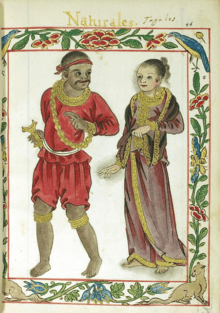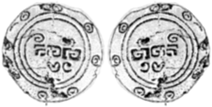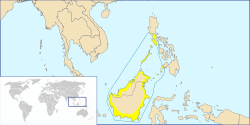History of the Philippines (900–1521)
| Geographical range | Southeast Asia |
|---|---|
| Period | Iron Age, High Middle Ages |
| Dates | c. 900–1521 |
| Major sites | Tondo, Madja-as, Butuan, Cebu, Sulu, Maguindanao, Limestone Tombs complex, Idjang citadels |
| Preceded by | Prehistory of the Philippines |
| Followed by | Colonial era |
This article covers the history of the Philippines from the creation of the Laguna Copperplate Inscription in 900 to the arrival of European explorer Ferdinand Magellan in 1521, which marks the beginning of the Spanish Colonial period.
The Laguna Copperplate Inscription (LCI) is the first written document found in a Philippine language. The inscription itself identifies the date of its creation as the year 900. Prior to its discovery in 1989, the earliest record of the Philippine Islands corresponded with the arrival of Ferdinand Magellan in 1521. The discovery of the LCI thus extended the record of Philippine history back by 600 years.[1][2] After 900, the early history of territories and nation-states prior to being present-day Philippines is known through archeological[3] findings and records of contacts with other civilizations such as Song Dynasty and the Bruneian Empire.
The Laguna Copperplate Inscription and its context (c. 900)

In January 1990, the Laguna Copperplate, then just a thin piece of crumpled and blackened metal, was offered for sale to and was acquired by the National Museum of the Philippines after previous efforts to sell it to the world of antiques had been unsuccessful. On examination, it was found to measure about 20 cm square and to be fully covered on one side with an inscription in ten lines of finely written characters. Antoon Postma deciphered the text and discovered that it identified the date of its creation as the "Year of Sakya 822, month of Vaisakha." According to Jyotisha (Hindu astronomy), this corresponded with the year 900. Prior to the deciphering of the LCI, Philippine history was traditionally considered to begin at 1521, with the arrival of Magellan and his chronicler, Antonio Pigafetta. History could not be derived from pre-colonial records because such records typically did not survive: most of the writing was done on perishable bamboo or leaves. Furthermore, zealous Spanish Christian missionaries burnt whole libraries of documents considered pagan. Because the deciphering of the LCI made it out to be the earliest written record of the islands that would later become the Philippines, the LCI reset the traditional boundaries between Philippine history and prehistory, placing the demarcation line at least 600 years earlier.[1][4]
The inscription forgives the descendants of Namwaran from a debt of 926.4 grams of gold, and is granted by the chief of Tondo (an area in Manila) and the authorities of Paila, Binwangan and Pulilan, which are all locations in Luzon. The words are a mixture of mostly Sanskrit along with some Old Malay, Old Javanese and Old Tagalog. The subject matter proves conclusively that a developed society with traders, rulers and international trading existed in the Philippines prior to the Spanish colonization. The references to the Chief of Medang Kingdom in Indonesia imply that there were cultural and trade links with empires and territories in other parts of Maritime Southeast Asia, particularly Srivijaya. The copperplate indicate the presence of writing and of written records at the time, and the earliest proof of Philippines language.[1]
Barangay city-states and Thalassocracy
Since at least the 3rd century, the indigenous peoples were in contact with other Southeast Asian and East Asian nations.

Fragmented ethnic groups established several chiefdoms formed by the assimilation of several small political units known as barangay each headed by a Datu, who was then answerable to a Rajah, who headed the city state. Each barangay consisted of about 100 families. Some barangays were big, such as Zubu (Cebu), Butuan, Maktan (Mactan), Irong-Irong (Iloilo), Bigan (Vigan), and Selurong (Manila). Each of these big barangays had a population of more than 2,000.
By the 14th century, there was a group of tribes organized thru strict social classes: The Datu or ruling class, the Maharlika or noblemen, the Timawa or freemen, and the dependent class which is divided into two, the Aliping Namamahay (Serfs) and Aliping Saguiguilid (Slaves).
In the earliest times, the items which were prized by the people included jars, which were a symbol of wealth throughout South Asia, and later metal, salt and tobacco. In exchange, the people would trade feathers, rhino horn, hornbill beaks, beeswax, birds nests, resin and rattan.
Emergence of Baybayin and related scripts (1200 onwards)


In a book entitled Tubod The Heart of Bohol published and accredited by the National Commission for Culture and the Arts of the Philippines, around the 12th century, a group of people from Northern Mindanao settled in the straight between mainland Bohol and the island of Panglao. Those people came from a nation in northern Mindanao called Lutao (probably the animist kingdom of what will soon be the Islamic Lanao). According to the much credited book, those people established the Kingdom of Dapitan in western Bohol because the true indigenous people of Bohol in the Anda peninsula and nearby areas were not open to them, forcing them to establish settlement in the western part of the island. The kingdom was first built with hardwood on the soft seabed. It engaged it trade with nearby areas and some Chinese merchants. The Jesuit Alcina tales about a rich nation he called the 'Venice of the Visayas', pointing to the Kingdom of Dapitan at that time. The Jesuit also tells of a princess named Bugbung Hamusanum, whose beauty caused her suitor to raid parts of southern China to win her hand. By 1563, before the full Spanish colonization agenda came to Bohol, the Kingdom of Dapitan was at war with the Ternateans of the Moluccas (who were also raiding the Rajahnate of Butuan). At the time, Dapitan was ruled by two brothers named Dalisan and Pagbuaya. The Ternateans at the time were allied to the Portuguese. Dapitan was destroyed and King Dalisan was killed in battle. His brother, King Pagbuaya, together with his people fled back to Mindanao and established a new Dapitan in the northern coast of the Zamboanga peninsula. The new Dapitan eventually was subjugated by the Spanish.[5]
The script used in writing down the LCI is Kawi, which originated in Java, and was used across much of Maritime Southeast Asia. But by at least the 13th century or 14th century, its descendant known in Tagalog as Baybayin was in regular use. The term baybayin literally means syllables, and the writing system itself is a member of the Brahmic family.[6] One example of the use of Baybayin from that time period was found on an earthenware burial jar found in Batangas. Though a common perception is that Baybayin replaced Kawi, many historians believe that they were used alongside each other. Baybayin was noted by the Spanish to be known by everyone, and was generally used for personal and trivial writings. Kawi most likely continued to be used for official documents and writings by the ruling class.[7] Baybayin was simpler and easier to learn, but Kawi was more advanced and better suited for concise writing.
Although Kawi came to be replaced by the Latin script, Baybayin continued to be used during the Spanish colonization of the Philippines up until the late 19th Century. Closely related scripts still in use among indigenous peoples today include Hanunóo, Buhid, and Tagbanwa.
Chinese trade (982 onwards)
The earliest date suggested for direct Chinese contact with the Philippines was 982. At the time, merchants from "Ma-i" (now thought to be either Bay, Laguna on the shores of Laguna de Bay,[8] or a site on the island of Mindoro[9][10]) brought their wares to Guangzhou and Quanzhou. This was noted by the Sung Shih (History of the Sung) by Ma Tuan-lin who compiled it with other historical records in the Wen-hsien T’ung-K’ao at the time around the transition between the Sung and Yuan dynasties.[9]
The growth of Islamic Sultanates (1380 onwards)
In 1380, Makhdum Karim, the first Islamic missionary to the Philippines brought Islam to the Archipelago. Subsequent visits of Arab, Malay and Javanese missionaries helped strengthen the Islamic faith of the Filipinos, most of whom (except for those in the north) would later become Christian under the Spanish colonization. The Sultanate of Sulu, the largest Islamic kingdom in the islands, encompassed parts of Indonesia, Malaysia and the Philippines. The royal house of the Sultanate claim descent from Muhammad.
Around 1405, the year that the war over succession ended in the Majapahit Empire, Sufi traders introduced Islam into the Hindu-Malayan empires and for about the next century the southern half of Luzon and the islands south of it were subject to the various Muslim sultanates of Borneo. During this period, the Japanese established a trading post at Aparri and maintained a loose sway over northern Luzon.
Attack by the Bruneian Empire (1500)

Around the year 1500, the Sultanate of Brunei under Sultan Bolkiah attacked the kingdom of Tondo and established a city with the Malay name of Selurong (later to become the city of Maynila)[11][12] on the opposite bank of Pasig River. The traditional Rajahs of Tondo, the Lakandula, retained their titles and property but the real political power came to reside in the House of Soliman, the Rajahs of Manila.[13]
Attack of the Spanish Conquistadores (1521–1565)
Filipino historians note an overlap in the history of pre-colonial Philippines and the Spanish colonial period, noting that while Magellan's arrival in 1521 marked the first arrival of European colonizers to this country, it was not until the arrival of Miguel López de Legazpi in 1565 that the Europeans had any marked impact on the lifestyle of the residents of the Philippine Archipelago.
National Historical Institute and National Commission for Culture and the Arts chair Ambeth Ocampo notes:
- Contrary to popular belief, the so-called “Spanish period” in Philippine history does not begin with Magellan’s arrival in Cebu and his well-deserved death in the Battle of Mactan in 1521. Magellan may have planted a cross and left the Santo Niño with the wife of Humabon, but that is not a real “conquista” [conquest]. The Spanish dominion over the islands to be known as “Filipinas” began only in 1565, with the arrival of Legazpi. From Cebu, Legazpi moved to other populated and, we presume, important native settlements like Panay and later Maynila (some thought the name was Maynilad because of the presence of Mangrove Trees in the area called nilad).[14]
| When | Who | Ship(s) | Where |
|---|---|---|---|
| 1521 | Trinidad, San Antonio, Concepcion, Santiago and Victoria | Visayas (Eastern Samar, Homonhon, Limasawa, Cebu) | |
| 1525 | Santa María de la Victoria, Espiritu Santo, Anunciada, San Gabriel, Santa María del Parral, San Lesmes and Santiago | Surigao, Islands of Visayas and Mindanao | |
| 1527 | 3 unknown ships | Mindanao | |
| 1542 | Santiago, Jorge, San Antonio, San Cristóbal, San Martín, and San Juan | Visayas (Eastern Samar, Leyte), Mindanao (Saranggani) | |
| 1564 | San Pedro, San Pablo, San Juan and San Lucas | Almost entire Philippines |
Primary sources for early Philippine history
Primary sources for this period in Philippine history are sparse, which explains why so little is known. This is evidenced by the Laguna Copperplate Inscription written in copper metal sheet. Historian William Henry Scott has provided a compilation and analysis of available archival primary source materials, linguistic analyses, archaeological, and other materials and analyzes several purported prehispanic historical accounts that lack any primary source documentation.[15]
The LCI is both the earliest local source on this era and the earliest primary source, with the Calatagan jar being more or less contemporary, although the translation of the text on the jar is in some question. Early contacts with Japan, China, and by Muslim traders produced the next set of primary sources.[16] Genealogical records by Muslim Filipinos who trace their family roots to this era constitute the next set of sources. Another short primary source concerns the attack by Brunei's king Bolkiah on Manila Bay in 1500. Finally, and perhaps with the most detail, Spanish chroniclers in the 17th century collected accounts and histories of that time, putting into writing the remembered history of the later part of this era, and noting the then-extant cultural patterns which at that time had not yet been swept away by the coming tide of hispanization.[11][17][18]
References
- 1 2 3 Laguna Copperplate Inscription - Article in English
- ↑ The Laguna Copperplate Inscription. Accessed September 04, 2008.
- ↑ Tomb raiders spoil Philippine archaeological find - FRANCE 24
- ↑ Postma, Antoon (June 27, 2008). "The Laguna Copper-Plate Inscription: Text and Commentary". Philippine Studies. Ateneo de Manila University. 40 (2): 182–203.
- ↑ http://ncca.gov.ph/publications/
- ↑ Baybayin, the Ancient Philippine script. Accessed September 04, 2008.
- ↑ Hector Santos. Kavi, a borrowed Philippine script. bibingka.com. Accessed April 35, 2010.
- ↑ Go, Bon Juan (2005). "Ma'l in Chinese Records - Mindoro or Bai? An Examination of a Historical Puzzle". Philippine Studies. Quezon City: Ateneo de Manila University. 53 (1): 119–138. Retrieved 2012-10-16.
- 1 2 Patanne, E. P. (1996). The Philippines in the 6th to 16th Centuries. San Juan: LSA Press. ISBN 971-91666-0-6.
- ↑ Scott, William Henry. (1984). "Societies in Prehispanic Philippines". Prehispanic Source Materials for the Study of Philippine History. Quezon City: New Day Publishers. p. 70. ISBN 971-10-0226-4.
- 1 2
- Scott, William Henry (1994). Barangay: Sixteenth Century Philippine Culture and Society. Quezon City: Ateneo de Manila University Press. ISBN 971-550-135-4.
- ↑ del Mundo, Clodualdo (September 20, 1999). "Ako'y Si Ragam (I am Ragam)". Diwang Kayumanggi. Archived from the original on October 25, 2009. Retrieved 2008-09-30.
- ↑ Santiago, Luciano P.R., The Houses of Lakandula, Matanda, and Soliman [1571-1898]: Genealogy and Group Identity, Philippine Quarterly of Culture and Society 18 [1990]
- ↑ Ocampo, Ambeth (January 22, 2009). "Legaspi's wish list". Looking Back: Legaspi’s wish list. Philippine Daily Inquirer. Retrieved February 5, 2009.
- ↑ Scott, William Henry. (1984). Prehispanic Source Materials for the Study of Philippine History (Revised Edition). New Day Publishers, Quezon City. 196pp. ISBN 9711002264.
- ↑ South East Asia Pottery - Philippines
- ↑ "Philippines | The Ancient Web". theancientweb.com. Retrieved 2016-03-04.
- ↑ Scott, William Henry (1992), Looking for the Prehispanic Filipino. New Day Publishers, Quezon City. 172pp. ISBN 9711005247.

